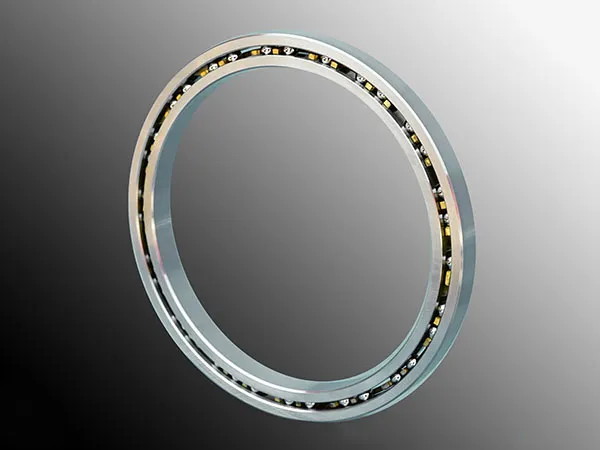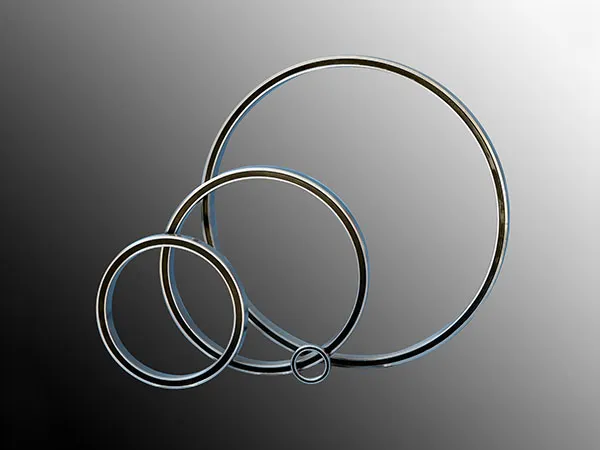Thin-wall bearings are crucial components in industrial robots, enabling precision movement within a compact design. However, their thin cross-section makes them more susceptible to damage if not properly maintained. Extending their lifespan requires a proactive and consistent approach.

Select the Right Lubricant: Choose a lubricant specifically recommended by the bearing or robot manufacturer. Consider factors like operating temperature, speed, load, and environmental conditions. Options include:
Grease: Suitable for most robot applications, offering good sealing and longevity. Ensure compatibility with seals (if present). Thin-section bearings are often shipped with a 20-30% fill of MIL-G-81322 grease for sealed types.
Oil: Can support higher speeds and offer better cooling but requires a more complex lubrication system. The oil level should typically reach the midpoint of the lowest rolling element in vertical mounts.
Solid Lubricants: For difficult-to-access bearings, consider porous polymers that release oil over time or dry film lubricants like Tungsten Disulphide or PTFE coatings.
Apply the Correct Amount: Avoid over-lubrication, which can attract contaminants, and under-lubrication, which leads to metal-on-metal contact and wear.
Lubrication Intervals: Follow the manufacturer's recommended relubrication schedule. Adjust based on the severity of the operating conditions.
Maintain Cleanliness: Ensure the lubricant is free from contaminants. Clean the lubrication points before applying new lubricant.
Seals and Shields: Utilize appropriate seals or shields to prevent the ingress of dust, dirt, moisture, and other debris. Inspect seals regularly for damage and replace them when necessary.
Clean Operating Environment: Minimize contaminants in the robot's working environment.
Proper Storage: Store spare bearings in a clean, dry environment, ideally in their original packaging, to prevent corrosion and contamination.
Gentle Handling: Avoid dropping or subjecting bearings to impact loads during handling and installation.
Correct Tools and Techniques: Use the proper tools for mounting and dismounting bearings. Incorrect installation can lead to misalignment and premature failure.
Proper Alignment: Ensure accurate alignment of the bearing and connected components to prevent uneven load distribution and stress. Avoid excessive force during installation.

Visual Inspections: Conduct routine visual checks for signs of wear, corrosion, damage, or leaks.
Noise and Vibration Monitoring: Listen for unusual noises or increased vibration, which can indicate bearing problems. Consider using vibration analysis tools for early detection.
Temperature Monitoring: Regularly check bearing operating temperatures. A significant increase can signal lubrication issues or excessive loads.
Check for Looseness: Inspect for any looseness in the bearing or its mounting.
Sensor Checks: Ensure any sensors related to the bearing's operation are clean, securely fastened, and functioning correctly.
Avoid Overloading: Operate the robot within its specified load limits. Excessive loads can drastically shorten bearing life.
Minimize Shock Loads and Vibrations: Design the robot's operation to reduce exposure to sudden impacts and excessive vibrations.
Temperature Control: Operate the robot within the bearing's specified temperature range. Extreme temperatures can degrade the lubricant and bearing material.

Joint and Gear Inspection: Ensure the robot's joints and gears move freely and are properly lubricated. Tighten any loose bolts or nuts.
Safety Mechanism Checks: Regularly test emergency stops and other safety features, as their proper function can prevent damage to the robot and its components, including bearings, in emergency situations.
Software and Firmware Updates: Keep the robot's software and firmware updated, as these updates can sometimes include improvements to motion control that indirectly benefit bearing life.
By implementing these maintenance practices, you can significantly extend the lifespan of thin-wall bearings in your industrial robots, ensuring smoother operation, reduced downtime, and lower overall maintenance costs. Remember to always consult the robot and bearing manufacturer's specific recommendations for the most effective maintenance procedures.
How to Improve the Surface Brightness of Slewing Bearings? 5 Effective Methods to Enhance Performance and Durability
2025-12-11 15:36How Long Is the Service Life of Slewing Bearings? Key Factors That Determine Durability
2025-12-05 14:26Customized Precision Crossed Roller Bearings: Unlocking Maximum Industrial Performance
2025-11-24 10:45How to Minimize Vibration in Precision Crossed Roller Bearings for Maximum Efficiency
2025-11-19 11:19Address: Lianmeng Road, Jianxi district, Luoyang City,Henan province.
E-mail: info@lynicebearing.com
Phone: +86-379-60689957
If you are interested in our products and services,
please feel free to contact us!
Get in tuch

+86-379-60689957
Lianmeng Road, Jianxi district, Luoyang City,Henan province.